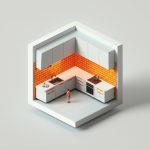Dreaming of a home perfectly tailored to your lifestyle? Building a house is a significant undertaking, and getting the floor plan right is the first, crucial step. This guide streamlines the process of obtaining custom floor plans. We’ll explore the diverse ways you can achieve a custom design, from comprehensive packages to individual services. We’ll guide you through each step, from the initial consultation to receiving your final blueprints. Sticking to your budget, collaborating with designers, and adhering to building codes will also be covered. For help with the design process, consider using floor plan software. Let’s transform building your dream home into an exciting experience!
Custom Floor Plan Services: Designing Your Dream Home with Personalized Blueprints
Building your dream home is a massive undertaking, but incredibly rewarding. Creating the perfect floor plan is one of the most crucial steps. Generic plans won’t suffice if you want a home designed for your unique lifestyle. Custom floor plan services transform standard blueprints into personalized works of art. Optimized spaces can increase property value significantly.
Choosing the Right Custom Floor Plan Service Model
There’s no one-size-fits-all solution when it comes to custom floor plan services. Several service models cater to various needs and budgets.
| Service Model | Description | Pros | Cons | Best Suited For… |
|---|---|---|---|---|
| Full-Service | A comprehensive package including initial consultation, design development, construction documents, and often construction oversight. | Stress-free, single point of contact, expert guidance, often includes permit assistance, project management included | The most expensive option, potentially less control over design details, may not be ideal for hands-on homeowners | Busy professionals, first-time homebuilders, those wanting a streamlined experience, those prioritizing convenience |
| A La Carte | Choose individual services as needed, such as initial design concepts, detailed blueprints, or 3D renderings. | Cost-effective if you only need specific services, greater control, budget-friendly, allows for piecemeal design | Requires more self-management, coordinating professionals, might be complex for those lacking design experience, time-consuming | Experienced DIYers, those needing revisions to existing plans, individuals with a clear vision and design skills |
| Hybrid Models | A flexible mix of full-service and à la carte options. | Balances cost and convenience, allows for customization, potentially more affordable than full-service, offers a degree of control and support | Requires careful review of the inclusions to ensure it aligns with needs and budget, potential for miscommunication | Clients seeking a middle ground, those with some design experience, those needing specific expertise and support |
Your Dream Home: A Step-by-Step Guide to Custom Floor Plan Services
Ready to bring your dream home to life? Let’s walk through the typical process:
-
The Initial Consultation
Meet with your chosen designer to discuss your vision, lifestyle, and budget. Bring inspiration photos, sketches, or mood boards. Be prepared to answer questions about how you envision using the space – how many bedrooms, kitchen layout preferences, etc. The more information you provide, the smoother the process.
2. Schematic DesignBased on your consultation, the designer will create a preliminary floor plan. This is a rough sketch outlining the basic layout of rooms. Thoroughly review this draft, offering feedback and suggestions. This is your chance to tweak the layout, ensuring it aligns with your family’s needs. Consider traffic flow, natural light, and accessibility.
3. Design DevelopmentThis phase transforms the basic layout into a precise blueprint. The designer incorporates your feedback, addressing building codes, site conditions (slopes, existing structures), and structural considerations. This is the stage where the plan starts to feel truly yours. Details such as window placement, door swings, and built-in features are finalized.
4. Construction DocumentsThe final stage involves creating detailed construction drawings. These are the precise blueprints that construction professionals use to build your home correctly. These technical drawings show precise measurements, material specifications, and structural details. They’re essential for obtaining permits and accurately carrying out the build. This set of documents will outline everything from electrical wiring to plumbing layouts to ensure the project is built to code.
5. Navigating Permits and ApprovalsThis often involves working with local authorities to ensure your plans meet all necessary building regulations and codes. A competent designer will assist you with this, simplifying the process and ensuring everything proceeds smoothly. Be prepared to provide additional documentation or make minor revisions as requested by the local authorities.
6. ConstructionThis is the most exciting part – watching your perfectly designed home take shape! While you won’t be directly involved in the day-to-day construction, your detailed plans ensure the project follows your vision precisely. Regular communication with the construction team will ensure the project stays on track and within budget.
Key Considerations
Budget: Determine your budget before you start. Discuss potential costs with your designer to avoid unexpected expenses down the road. Remember to include contingency funds for unforeseen issues. Research average building costs in your area to provide a realistic budget.
Timelines: Custom designs don’t happen overnight. Be realistic, build in buffer time for potential delays, and work closely with your designer to set clear expectations. Factors such as the complexity of the design, the designer’s workload, and local permitting processes can all impact the timeline.
Communication: Maintain open communication with your designer throughout the entire process. Regular updates, feedback sessions, and clear communication are key to ensuring everyone is on the same page and your vision comes to life. Use online project management tools or regularly scheduled meetings to ensure efficient communication.
Finding the Right Designer
Your designer is your partner. Thoroughly research candidates, examining their portfolios, reading reviews, and asking important questions. Get a feel for their design style and see if it aligns with your own preferences. Check their credentials and experience with similar projects. This investment is worth the time and attention, because a designer is there to help solve specific problems.
Remember, your home should reflect your lifestyle and personality – a custom floor plan is the first step in achieving that dream. So, take a deep breath, take your time, and create a home that will last a lifetime.
How to Choose the Right Custom Home Design Firm
Key Takeaways:
- Thoroughly vet potential firms: Check licenses, insurance, financial stability, and portfolios.
- Prioritize open communication and long-term relationships, not just the lowest price.
- Understand different service models (full-service vs. à la carte) and choose the best fit for your needs and budget.
- Secure financing early – a construction-to-permanent loan is often ideal.
- Account for unforeseen issues; build a contingency fund, and prioritize project management capabilities.
- Carefully review contracts and budgets before signing.
Understanding Your Needs and Budget
Before diving into the exciting world of custom home design, you must define your vision. What kind of home do you envision? What features are must-haves? What are your budgetary limitations? This self-assessment is crucial for how to choose the right custom home design firm. Consider your lifestyle, family size, and long-term goals when defining your needs.
Different Service Models
Custom home design firms offer various service packages. It’s like ordering a meal; you can choose from a prix fixe menu (full-service) or select individual components (à la carte).
- Full-Service: This encompasses everything from initial concept sketches to final construction documents. It’s convenient, but the cost is typically higher.
- À la carte: You only pay for specific services, like initial design consultations, floor plan development, or construction drawings. This approach offers greater control and flexibility, allowing you to tailor the process to your budget while potentially requiring you to manage different professionals. Consider your own expertise, the complexity of the project, and the time you’re willing to commit.
Step-by-Step Guide to Choosing Your Design Firm
- Define Your Requirements: Create a detailed wish list, outlining your needs and wants. Include the style preferences, desired space layout, and must-have features. Be as specific as possible about your needs, from the number of bedrooms and bathrooms to the type of kitchen appliances you want.
- Research & Shortlist: Look for firms with a proven track record. Online reviews, referrals, and professional organizations can help identify potential candidates. Check their licenses and insurance. Ask for references from previous clients.
- Request Proposals: Contact your shortlisted firms and share your detailed requirements. Ask for detailed proposals outlining their services,
- Modern Kitchen Backsplash Ideas To Inspire Your Refresh - December 19, 2025
- Modern Backsplash Ideas: A Guide to Todays Kitchen Trends - December 18, 2025
- Ceramic Kitchen Wall Tiles: Style and Protection for Your Walls - December 17, 2025









